Here is what I thought I knew about Harry Potter: everything.
I have read every book and can quote every movie. I can name the actors who play the major characters, and how they were casted. I can name all the minor characters and describe every detail of the plot. I can list facts about the characters that only a small portion of Harry Potter fans would understand. I can talk about why this series is so amazing and why it has had such a profound impact on who I am. I can rant about how my childhood wouldn’t have been the same without this series. But honestly, none of this matters.
Now, do not take this to mean that I was obsessed with these books. I was unreasonably obsessed. Instead of doing homework or having fun, I would read. I would buy the next book in the series before I was even half way through the one before. I read each one so fast that wanted to make sure I could get my hands on the next book as soon as possible. A second could not be spared. My life seemed to revolve around the stories that J.K. Rowling told. I was so drawn to this imaginary world that I removed myself from reality.
As young as I was when I read the series, I only could digest the information that was in pain sight. All the clear-cut elements of the story were easily accessible to my young mind, and I was taking everything in. I wanted to know all that could be known about this new world, and I thought I did.
According to Chuck Klosterman, there are three kind of information:
- “Information that you know you know.
- Information that you know you don’t
- Information that you don’t know you don’t know” (Klosterman 2007).
Looking back now on my knowledge of Harry Potter, I would say that I fall into the third category. I thought I knew everything, but there was so much I wasn’t aware of. I feel that young viewers are so blinded to the real but hidden messages in the series. I was blinded because of my age and my love for the series. Despite the constant war between good and evil present in the movies, we all wish we could be a part of this fantasy. Readers become obsessed with the fake reality and desire to be a part of the wizarding world. We even created one in Orlando, Florida! However, there is something that we haven’t noticed in Harry Potter: racial notions. The movies seemingly eliminate race by creating an almost entirely white wizarding world, but it creates a new racial hierarchy among magical and non-magical people. The battle between good and evil is a racial war. Viewers are unaware of this racial tension because it has been manifested in a different way. The racial war takes place in a seemingly non-racial way.
J.K. Rowling has created a world that seemingly transcends the social construct of race by creating a new, almost entirely white, world. At first glance, Harry Potter seems to have no racial storyline. White people control both sides of the war. The fate of the wizarding world is left in their hands. The non-white minorities are essentially left to watch as the future of their world is fought over. I realize that by showing how white people control both sides of the war, I am not explaining the racial tension. Lord Voldemort (the Dark Lord) is the leader of the evil forces. The Dark Lord is summoned by the Dark Mark, which is a figure sent into the air.
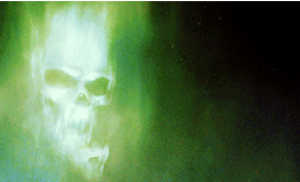
The Dark Mark’s purpose is not only to summon the Dark Lord. It is also used as a threat, creating tremendous fear. The Dark Mark can only be produced by a loyal member of Voldemort’s forces.
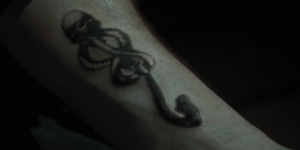
These members have a physical mark of darkness on their arm to show their loyalty to evil. Instead of using traditional racial stereotypes to signify evil, J.K. Rowling uses white men with dark marks as evil figures. In this white wizarding world, the evil ones are just a little darker than the rest.
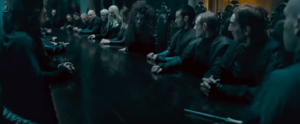
The notion that darkness in the mist of whiteness represents evil as a clearly racist notion. Being darker or having dark marks on your skin represents evil according to the Harry Potter series. This dark mark is easily covered up by these characters. Therefore, the darkness isn’t something that we can see in plain sight just by looking at a character. Thus, race can be hidden within characters, hidden from viewers.
The evil white characters show a slight darkness inside of them, but where do the actual non-white characters come into play? In an almost entirely white series of movies, minorities have a total of six minutes of dialogue. Eight movies and only six minutes of dialogue. These characters barely seem to exist.
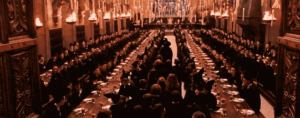
Picture of Hogwats students where almost everyone appears to be white
Non-white characters: https://www.youtube.com/watch?v=x67OjOLj11g
These characters additionally have seemingly easily replaceable, inconsequential roles. The uniqueness of their identities is cast out the window, which further marginalizes the minorities. The presence of these characters doesn’t distract from the fact that the wizard world is entirely white, so why did J.K. Rowling bother to include them? The casting a few non-white minor characters helps to create the white world because these characters seem out of place. The inclusion highlights the exclusion and aids in creating a world dominated by whiteness.
Within the wizarding and non-wizarding worlds, another separation is created. All magical beings are placed above humans. Wizards refer to humans as “muggles,” which can be translated to mean a person with no skill or ability. Muggles are seen as weak and inferior to wizards because of their lack of power. However, there are muggle parents who give birth to wizards. Hermione, as an example, is referred to as a mudblood by evil characters. The word Mudblood literally translates to dirty blood. Voldemort and his followers take wizard superiority to a new level. He believes that wizardry should be kept within all magical families (pure bloods), and people like Hermione should be killed. Harry Potter and his supporters separate from Voldemort on this very point. They believe that all are equal. No wizard is greater than any other. Voldemort’s blood purification is comparable to the Hitler’s Nazi regime in Germany in the 20th century. Hitler believed in the extermination of Jews, and Voldemort believes in wiping out impure wizards. J.K. Rowling’s wizarding world has created a hierarchy that on the surface doesn’t appear to be about race but in reality, is solely about it. Viewers, especially young people, watch the series and immediately call Voldemort a murderer and claim that is what separates the good and the evil. However, we miss over the fundamental fact that he is killing to gain power and purify the wizarding race. There are two main characters who will help clarify Voldemort’s beliefs. First, Rubeus Hagrid is half wizard and half giant.
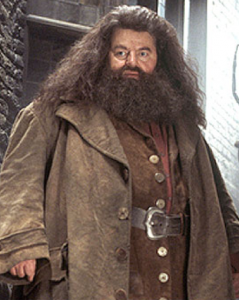
He has all of the magical capabilities that any other wizard has, yet he is treated by the Malfoys and other supporters of Voldemort as nothing but a dumb giant. These evil characters treat him as inferior simply because of who he is. Though not apparently about race, Hagrid’s treatment by the evil wizards is clearly about wizard race. Second, Hermione Grander has two human parents. However, she somehow became a wizard. She also is treated terribly by the evil characters, especially Draco Malfoy. Because her bloodline is “impure” she is viewed as weak and lower in status. Despite her non-magical blood line, Hermione is the brightest student in her class.
https://www.youtube.com/watch?v=nAQBzjE-kvI
She demonstrates above average knowledge and ability, despite her magical race. Overall, having an entirely white world seems to eliminate racial tensions. However, the new racial hierarchy created between people of different magical biology exemplifies the manifestation of a different racial battle in Harry Potter. Also, it is plausible that the impure white characters in a way represent nonwhite people (despite their white skin color) because of how they are viewed and treated by the pure wizards. The wizarding world therefore represents a racial battle, which further illuminated J.K. Rowling’s shift in racial relations from actual races to wizarding races.
The superiority of pureblood wizards can be equated to white dominance. Voldemort strongly stands by the idea that his race of wizards is better than all others and is the only group fit to control the wizarding world. There is no other family who agrees with him more than the Malfoy’s. Lucius and Draco Malfoy are the epitome of white privilege and narcissism. Their appearance and attitude attempt to emanate superiority. Both of them have bleach, blonde hair. Their hair is as close to white as hair can get.
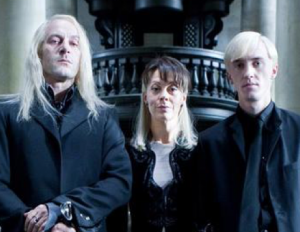
They are one hundred percent pure blood wizards with opulent wealth and flaunt it whenever possible.
https://www.youtube.com/watch?v=lG1UytBbJpE
The Malfoys are as white as white can get, and they use their status to their advantage. Ironically, the epitome of whiteness is one of the main representations of darkness. Additionally, The Malfoys belittle everyone who threatens them. However, they are the weak ones. In every battle, they either lose or run away.
https://www.youtube.com/watch?v=jrrrWuIYaGU
https://www.youtube.com/watch?v=JB2ZfDph1pE
https://www.youtube.com/watch?v=quyH6bvLqfA (at the end)
Additionally, Voldemort ultimately loses to Harry Potter. The good, impure forces defeat the evil, pure forces.
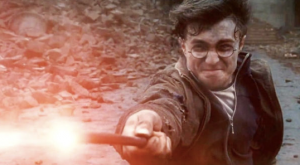
https://www.youtube.com/watch?v=ITqYqMNF4R8
The evil characters view the impure as genetic mistakes. However, these biological differences are what makes the good characters more human and better than the pure wizards. J.K. Rowling has changed the racial stereotypes. The impure wizards are the brightest, and the pure, extremely white wizards are weak. Viewers are blind to this change in racial stereotypes because it is hidden underneath wizard races.
Now, I realize that I need to discuss two main characters who also help explain J.K. Rowling’s racial reversal. Ron Weasley and Harry Potter. Ron is a pure blood wizard.
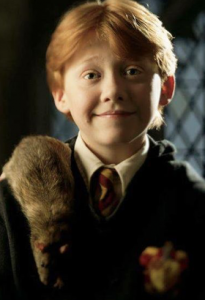
However, his family doesn’t have a lot of wealth. Additionally, Ron’s father is fascinated with muggles. The Weasley family despite their pure blood status, isn’t treated nicely by the Malfoys and other supporters of Voldemort because of their lack of wealth and association with muggles. Ron shows tremendous bravery and sacrifice, human traits that evil wizards lack. Now, the main character, Harry Potter, is a half-blood wizard.
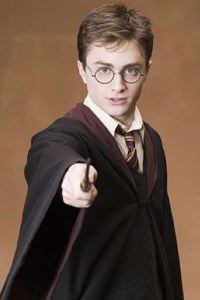
His father was a pure blood wizard and his mother had two muggles parents. Therefore, he lacks complete purity. However, he becomes the most powerful wizard in history. His mother sacrificed herself to protect him, which gave him more power than any evil force. The human love inside of him is what allows him to defeat evil, not biological wizarding power. Overall, complete whiteness, purity, and wealth are associated with inhumane evil. Ron and Harry, both “impure” wizards, successful defeat evil. This is another example of J.K. Rowling’s reversing of racial associations. The purest form of wizardry isn’t the most powerful.
Not only is there a difference between pure and impure wizards, there is a magical hierarchy within the creatures of the wizard world. I am going to discuss two creatures who have racial and stereotypic connections to the human world. The Goblins in Harry Potter control Gringotts, the wizarding bank. These big nosed creatures are regarded as mistrustful and greedy. https://www.youtube.com/watch?v=mcMjdSk9EfY (Griphook leaves Harry, Ron, and Hermione because he got the sword).
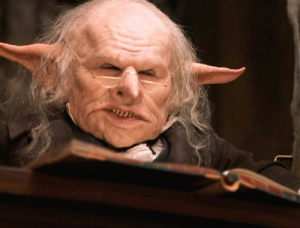
(Griphook: main goblin)
These goblins embody the stereotypes associated with Jews. Jewish moneylenders have been stereotyped as extremely wealthy, deceitful, and having big noses. All of these features are present in goblins. Second, the house elves are represented as the lowest level of society. They are essentially enslaved by their masters and can only be freed when presented with clothes. These creatures depend on their masters to survive and live in fear of punishment. Dobby, a house-elf of the Malfoy family, is a perfect example. He wears a dirty pillowcase, is beaten by his master, and even punishes himself when he disobeys.
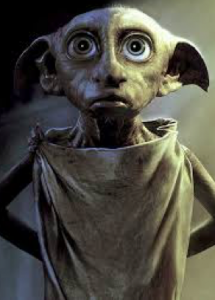
Dobby worked for the Malfoys, who are the epitome of whiteness in the Harry Potter series. House-elves clearly provide a direct comparison to enslaved African Americans in 17th to 19th century America. Slaves are completely submissive to their masters will and live in fear. House-elves and slaves were both treated as nothing. African Americans didn’t even count as people, and house-elves are regarded as worthless. Both goblins and house-elves provide connections to human stereotypes and racial prejudices that upon watching Harry Potter for the sole enjoyment of the series, we are blind to. We are not aware of these connections because these characters seem virtually trivial to the plot and aren’t present in the battle between good and evil. J.K. Rowling has hidden these racial messages in places where viewers won’t notice them.
Carin Möller, a Lund University graduate, wrote her Bachelor’s thesis on Harry Potter, in which she states, “Indeed, the racial identifiers seem to exist only as a vehicle for Rowling to show how race has no real meaning in her magical universe” (Möller 2014 page 3/234). I agree that the white world she created essentially signifies that the race of her characters is inconsequential. However, having replaceable minority characters excludes them because their fate is determined by white people. She may as well have never included them. Harry Potter proves that race in general does have meaning. Carin is just like every other viewer. She overlooks the underlying messages about race by claiming race has no meaning in J.K. Rowling’s magical universe. Race has meaning; however, it is hidden in seemingly non-racial relations. Racial meaning is present in pure versus impure wizardry, in the inferiority of magical creatures, and in the darkness hidden within the white characters.
Mikhail Lyubansky of the University of Illinois claims, “the racial issues of Rowling’s story about young wizard Harry Potter can be found in every corner.” (Lyubansky page 19/17). The presence of racism is not as easily accessible to the target viewers of Harry Potter, young kids, as this author makes it seem. They are also not found in every corner. They are hidden in the magical and non-magical tension. The simple creation of a mainly white world doesn’t provide racial tension. Readers of Harry Potter see a false form of racial tension in this world because we aren’t aware of the deeper meanings behind the relationships between characters. When we see the evil characters get defeated, we don’t immediately connect their defeat to their poor treatment of house elves and impure wizards. Over time we may become more aware of the causes of their defeat. However, young viewers and first time watchers cannot see the causes of downfall of Voldemort and his forces. We notice Voldemort’s attempt to purify the wizarding race, but it is almost impossible to notice the underlying messages about white superiority, non-white exclusion, and racial reversals. Even many adults still haven’t noticed the presence and significance of race in these films. It is difficult to uncover and must be searched for in unexpected places.
Overall, one might argue that because Harry Potter defeats Voldemort we are suddenly aware that Voldemort was wrong in trying to purify the wizard race and all magical race is now obvious to viewers. I disagree with this argument. There are certain aspects of race that we are aware of. We immediately notice skin color. J.K. Rowling has created an almost entirely white world, in which the fate of the minority depends on the white characters. There is a battle between which whiteness is better. The pure blood evil characters, who have slight darkness in the midst of the complete whiteness, or the impure good characters, who have more lightness and purity that the pure blood characters. Upon watching Harry Potter, we simply see good and evil. We see light and dark; pure and impure. However, we can’t see how J.K. Rowling has ironically flipped the racial connotations. The epitome of whiteness and purity carries the dark mark. They are weaker than they perceive themselves to be because of their irrational desire for a wizarding world of complete purity. They lack human traits of love, friendship, and sacrifice, and the biologically flawed characters rise up to defeat the evil ones. They have strength, intelligence, and bravery-traits that are usually associated with the purity and wealth of complete human whiteness. These characteristics in the real world aren’t stereotypically associated with the poor, dirty blood, and low life people (wizards). J.K. Rowling has created a more positive outlook on race. Anyone can have any trait. Even the whitest wizards can be the evilest, and even the most impure wizards can courageously save their race from extinction. The ideology is that pure white domination is wrong and impure whites can be smarter and stronger. Therefore, Harry Potter is a call for equality, overturning the status quo of white domination. This view of the race present in Harry Potter isn’t obvious. It is hidden in the backgrounds of the characters. This type of race isn’t always seen when you see the characters in the movie. We can’t see who is pure and who is impure just by looking at them. Race in Harry Potter isn’t always turned on and is therefore difficult to uncover and analyze. J.K. Rowling created a white world so that she can develop race relations between the magical characters and almost completely hide them from viewers.
Written in the style of Chuck Klosterman
Edited by Ashley Zhou
References
Klosterman, Chuck. “Death by Harry Potter.” Esquire 2007.
http://www.esquire.com/entertainment/a3556/klosterman1107/
Lyubansky, Mikhail “The Psychology of Harry Potter.” Benbella Books Inc.
https://internal.psychology.illinois.edu/~lyubansk/Harry%20Potter.pdf
Möller, Carin “Mudbloods, Half-bloods and Pure-bloods.” 2014.
http://lup.lub.lu.se/luur/download?func=downloadFile&recordOId=4285141&fileOId=4285142
Rowling, J.K. Harry Potter and the Philosopher’s Stone. London: Bloomsbury Publishing, 1997. Print
Rowling, J.K. Harry Potter and the Chamber of Secrets. London: Bloomsbury Publishing, 1998. Print
Rowling, J.K. Harry Potter and the Prisoner of Azkaban. London: Bloomsbury Publishing, 1999. Print
Rowling, J.K. Harry Potter and the Goblet of Fire. London: Bloomsbury Publishing, 2000. Print
Rowling, J.K. Harry Potter and the Order of the Phoenix. London: Bloomsbury Publishing, 2003. Print
Rowling, J.K. Harry Potter and the Half-Blood Prince. London: Bloomsbury Publishing, 2005. Print
Rowling, J.K. Harry Potter and the Deathly Hallows. London: Bloomsbury Publishing, 2007. Print
Images from Google and Video clips from Youtube